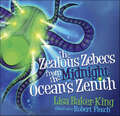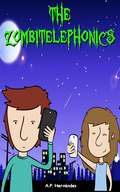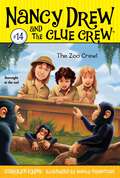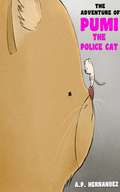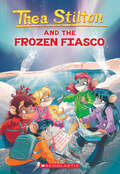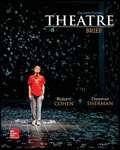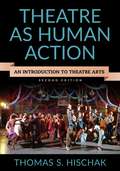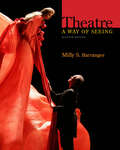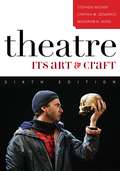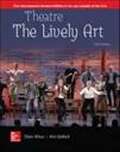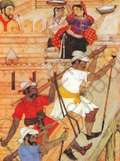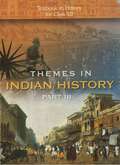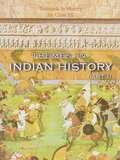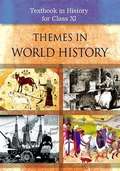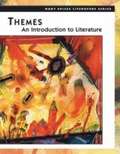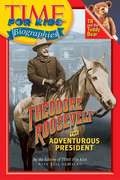- Table View
- List View
The Youngest Marcher: The Story Of Audrey Faye Hendricks, A Young Civil Rights Activist
by Cynthia LevinsonNIMAC-sourced textbook
The Zealous Zebecs from the Midnight Ocean's Zenith
by Lisa Baker-KingSleep is the last thing on the minds of this sister and brother who are about to meet some strange, beautiful and quite questionable characters!Follow them and the clues as they look for Annie the Amazing Angelfish while weathering winds, summoning superpowers, forging friendships and fending off foes fathoms below the foamy surface of the surging seas."The Zealous Zebecs from the Midnight Ocean's Zenith" joins an imaginative story with intense alliteration, and engages children in a seek-and-find to celebrate the spoken sound of the written word. Each letter of the alphabet creates a humorous symphony of sounds and encourages the child and their loved ones to experience language together. Zebecs.com
The Zip Line (Fountas & Pinnell Classroom, Guided Reading Grade 3)
by Gideon Kendall John BridgerNIMAC-sourced textbook
The Zombitelephonics: A Book for Children Ages from 8-9 to 10-12
by A. P. HernándezBut what is going on? The mobiles have absorbed people's minds. They are so dumbed by their cellphones that they look like zombies. Loli, Hugo, Eric and Alvaro have to save the world. Are you ready? Three...Two...One... Here we go!
The Zoo Crew (Nancy Drew and the Clue Crew #14)
by Carolyn KeeneThis camp is WILD! Nancy, George, and Bess are attending a three-day overnight camp at the local zoo. They'll get to spend lots of time with all of the animals and learn about them too. The best part is, they will be helping the zookeeper make toys for the animals -- just like real staffers! But when the toys the girls make by day are disappearing at night, it looks like everyone is a suspect! Can Nancy tame this wild case, or will the zoo animals be without anything fun to do?
The Zookeeper (Fountas & Pinnell Classroom, Guided Reading)
by Jesse JamesNIMAC-sourced textbook. Lunch Time at the Zoo. The zookeeper feeds the animals at the zoo. Each animal gets something different.
The adventure of Pumi, the Police Cat: Book recommended for children and preteen between 6-7 and 10-11 years old.
by A. P. HernándezPumi is a very special cat. Unlike his brothers, who enjoy hunting, scratching sofas and racing, Pumi likes to watch the stars, ask questions and, above all, doing justice. He wants to become a police dog when he grows, and that is why he asks Moe the library mouse to help him learn how to read and write. But things aren’t as easy as they seem. Trying to enter the police force, Pumi finds himself in a world ruled by dogs and prejudice, a world where cats, no matter how brave they are, have no place. The obstacles in his way will test his determination, strength and perseverance, while they will help him meet new friends and live great adventures. Book recommended for children and preteen between 6-7 and 10-11 years old.
Thea Stilton and the Frozen Fiasco: A Geronimo Stilton Adventure (Thea Stilton #25)
by Thea StiltonJoin Thea Stilton and the Thea Sisters on an adventure packed with mystery and friendship!One of the Thea Sisters' favorite authors, a famouse mystery writer, has disappeared! To find him, the five mice travel to his native Iceland. Together they traverse the stunning landscape and reconstruct the plot of the author's latest novel. But it's more dangerous than they expected! Can the mouselets locate their beloved author, or will their search just end up as an icy mess?
Thea y el piensacuario (¡Arriba la Lectura! Level S #28)
by Cameron Macintosh Giulia RivoltaNIMAC-sourced textbook <p><p> Thea siempre quiso tener un pececito, así que se entusiasma cuando su hermano le habla de los piensacuarios. Con un par de auriculares puestos, te imaginas lo que quieres ver en la pecera y luego ¡aparece! Pero cuando las criaturas que se imagina Thea comienzan a tener ganas de comer cacahuates, el piensacuario ya no parece tan divertido. ¿Podrá Thea desimaginar las criaturas antes de que sea demasiado tarde?
Theatre Appreciation Online: Course Number THE 2000
by Stephen NealThis Theatre Appreciation Online course textbook for Florida International University students provides an extensive study on What Is the Theatre, What Is a Play, The Playwright, The Critic and the Dramaturg, The Actor, The Director, Designers and Technicians, Theatre Traditions: East and West, and The Modem Theatre.
Theatre Brief Eleventh Edition
by Robert Cohen Donovan ShermanRobert Cohen and Donovan Sherman's Theatre Brief, 11th Edition, continues to provide an insider's guide to the world of theatre, where students are given a front-row seat. This lively introduction to theatre offers equal measures of appreciation of theatrical arts, history of performance, and descriptions of the collaborative theatrical crafts. Coverage of design, acting, and directing, as well as photo essays, provide a behind-the-scenes look at professional theatre artists performing their craft. Play excerpts and outlines represent a wide range of theatrical achievement. Theatre Brief offers a vast updating of contemporary theatre in America and abroad.
Theatre as Human Action: An Introduction to Theatre Arts
by Thomas S. HischakMost introductory theatre textbooks are written for theatre majors and assume the student already has a considerable amount of knowledge on the subject. However, such textbooks may be counterproductive, because they reference several works that may be unfamiliar to students with limited exposure to theatre. Theatre as Human Action: An Introduction to Theatre Arts, Second Edition is designed for the college student who may be unacquainted with many plays and has seen a limited number of theatre productions. Focusing primarily on four plays, this textbook aims to inform the student about theatre arts, stimulate interest in the art form, lead to critical thinking about theatre, and prepare the student to be a more informed and critical theatregoer. <P><P>In addition to looking at both the theoretical and practical aspects of theatre arts—from the nature of theatre and drama to how it reflects society—the author also explains the processes that playwrights, actors, designers, directors, producers, and critics go through. The four plays central to this book are the tragedy Macbeth, the landmark African American drama A Raisin in the Sun, the contemporary rock musical Rent, and—new to this edition—the American comedy classic You Can’t Take It with You. At the beginning of the text, each play is described with plot synopses (and suggested video versions), and then these four representative works are referred to throughout the book. <P><P>This second edition also features revised chapters throughout, including expanded and updated material on the technical aspects of theatre, the role of the audience and critic,and the diversity of theatre today. Structured into nine chapters, each looking at a major area or artist—and concluding with the audience and the students themselves—the unique approach of Theatre as Human Action thoroughly addresses all of the major topics to be found in an introduction to theatre text.
Theatre: A Way of Seeing
by Milly S. BarrangerConsistently praised as "streamlined" and "clear and student friendly," THEATRE: A WAY OF SEEING offers the beginning theatre student an exciting, full-color introduction to all aspects of theatre. It presents the experience of theatre, who sees it, what is seen, and where and how it is seen largely from the viewpoint of audiences exposed to a complex, living art that involves people, spaces, plays, designs, staging, forms, language, and productions. The book includes the appropriate coverage of the history, diversity, and most critical moments in theatre in a way that encourages students to experience theatre as "a performing art and humanistic event."
Theatre: Its Art and Craft
by Stephen Archer Cynthia M. Gendrich Woodrow B. HoodTheatre: Its Art and Craft is an introductory theatre text focusing on theatre practitioners and their processes. Using an accessible tone and a focused exploration of how theatre artists work, the book covers playwrights, directors, actors, designers of sets, costumes, props, lights, sound, and new technology, as well as the varying roles of scholars, critics, and dramaturgs. Appropriate for beginning theatre majors, minors, or non-majors, Theatre: Its Art and Craft helps students understand how theatre happens, who makes it, and what they do. Updated with new statistics, references, and photographs, the sixth edition now features an overhauled design section: the authors have divided the design chapter into two parts: one focused on the tactile elements of design (sets, costumes, props) and the second on the temporal elements (lights, sound, and new technologies).
Theatre: The Lively Art
by Edwin Wilson Alvin GoldfarbTheatre: The Lively Art remains the best-selling program for Theatre Appreciation courses. With its hallmark focus on preparing future audience members, students will learn how theatre functions, how it should be viewed and judged, and the transition behind any performance they may attend.
Themes In Indian History Part 2 class 12 - NCERT
by National Council of Educational Research and TrainingAn apt choice of textbook for students of Class 12, this textbook "Themes in Indian History Part - 2" will give the students an insight of Indian history. It has been published by NCERT and strictly follows the guidelines and syllabus defined by the Central Board of Secondary Education (CBSE). This book has been designed to enrich the knowledge of the students about the Mughal Empire, Agrarian Society and other past events. The significant events have been explained in a chronological order to have a better understanding of historical occurrences and their causes.
Themes In Indian History Part-3 class 12 - NCERT - 23 (History)
by National Council Of Educational Research And Training"Themes in Indian History Part III" by NCERT is a comprehensive book that explores significant themes in Indian history. It covers topics such as colonialism's impact on rural India, resistance movements against British rule, urbanization and architecture during the colonial period, Mahatma Gandhi's ideology and influence, and the partition of India in 1947. This book provides a multidimensional approach to understanding Indian history, considering political, socio-cultural, and economic factors. Through detailed analysis and the use of oral sources, it offers readers a deeper understanding of the complexities and nuances of India's past. Aimed at students and history enthusiasts, "Themes in Indian History Part III" serves as an invaluable resource, encouraging critical thinking and providing insights into the country's rich historical heritage.
Themes in Indian History Part-2 class 12 - NCERT - 23 (History)
by National Council Of Educational Research And Training"Themes in Indian History Part – II" by NCERT is a comprehensive exploration of key themes in India's past. It covers the rise and expansion of the Mughal Empire, regional kingdoms, and their interactions with the Mughals. The book also delves into the impact of British colonialism, the Indian Nationalist Movement, and the process of nation-building after independence. With insights into political, social, and cultural dimensions, it examines prominent rulers, colonial encounters, and the struggles for independence. Through its concise yet informative narrative, the book fosters a deeper understanding of India's history, encouraging critical thinking and appreciation for the country's diverse heritage.
Themes in Literature (4th edition)
by Jan AndersonEach anthology in the A Beka Book literature series is a valuable tool to the Christian young person seeking to increase his knowledge of good literature. The student will be exposed to a wide variety of short stories, poems, essays, and plays and to a good balance of serious and humorous selections from some of the finest writers of world literature. Works included in this series have been chosen for their literary and moral merit. Although A Beka Book may not endorse the entire contents of each selection or the work from which it is taken, selections reflect Christian principles with an emphasis on character-building and life-enriching themes. * Part of the learning process is developing proper discernment according to the truths of the Scripture, realizing that while a Christian may not be able to entirely approve of an author's beliefs, lifestyle, or work, he can appreciate the author's God-given talent. Selections included in Themes in Literature are intended to increase the student's appreciation of literature and help him develop a love for reading. The main goal of the text is to provide enjoyable prose and poetry for student reading.
Themes in World History class 11 - NCERT - 23 (History)
by National Council of Educational Research and Training"Themes in World History" for Class 11 by NCERT offers a comprehensive overview of global historical events, from early human societies to the modern era. It chronicles the transition from hunter-gatherers to settled agricultural communities and the rise of empires across continents, emphasizing their cultural and scientific contributions. The book underscores the importance of trade routes, such as the Silk Road, in catalyzing cross-cultural exchanges. It delves into the age of industrialization, colonization, and the subsequent rise of nationalism. The global impacts of the World Wars and the ideological battles of the Cold War era are detailed. Concluding with the post-Cold War and globalization era, the textbook encourages students to understand the interplay of events and ideologies in shaping today's world.
Themes: An Introduction to Literature
by BurkeThis book takes a scientific look at global warming. Reading Essentials in Science.

